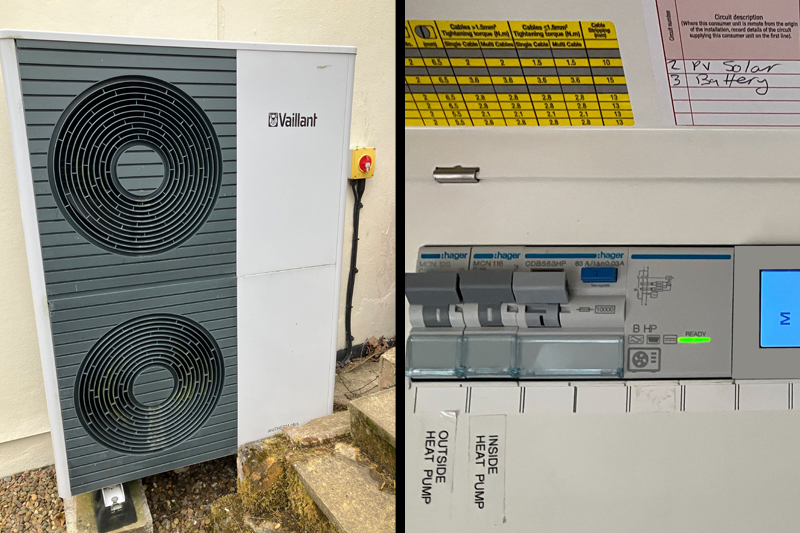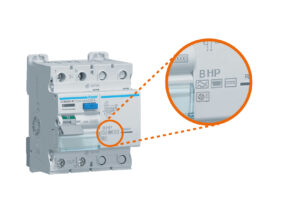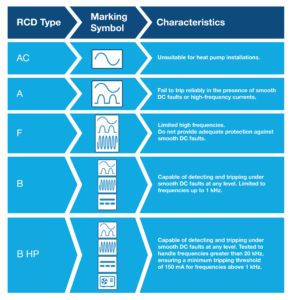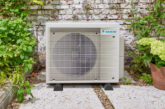
In this real-life case study example, we learn more about how Hager’s Type B HP RCD has helped to solve a two-year heat pump tripping issue for a former BEAMA CEO.
As part of his personal commitment to sustainable technologies, Dr. Howard Porter, former CEO of BEAMA and a long standing advocate for the UK’s low carbon future, made the decision to have a heat pump installed at his property.
As someone who has spent decades supporting the electrification of heating and the wider energy transition, his home was fitted with not only an air source heat pump but also a solar PV array and battery storage system, all designed to work harmoniously for efficiency and environmental benefit.
But shortly after installation, Dr. Porter began experiencing frustrating disruptions. His heat pump system would regularly shut down, leaving him without heating and hot water. The issue persisted, and despite expert input and several attempts to rectify it, the intermittent tripping of the 30 mA Type A RCBO continued for two years.
“It’s been a constant battle with the heat pump,” said Dr. Porter. “We tried everything from replacing devices to adjusting sensitivity settings. It became a real inconvenience and started to erode my faith in the technology.”
Identifying the true cause: consumer unit sharing with PV and battery
Initially, the problem appeared to be isolated to the heat pump’s own circuit, protected by a 30 mA Type A RCBO.
It was identified that the consumer unit was shared between the heat pump, the solar PV system, and battery storage, all of which included inverter-based components. It was established that a 30 mA RCD was required to conform to the requirements of BS 7671 for the electrical installation arrangements and the heat pump safety standard BS EN IEC 60335-2-40.
This shared configuration created a complex electrical environment. The PV and battery systems were introducing compound mixed electrical leakage frequencies and DC currents in normal operation and the Type A RCBO protecting the heat pump circuit didn’t have suitable characteristics to avoid repeated unwanted tripping. It is important to note that no fault existed.
The problem wasn’t a heat pump fault, it was the interaction between multiple inverter-based systems using a protection device with incompatible characteristics.
The solution: Hager Type B HP and circuit separation
Recognising the complexity of the issue, Hager’s technical team recommended a full reconfiguration of the circuit protection arrangements.
The heat pump circuits were reconfigured, dispensing with the Type A RCBO and using MCBs downstream of a Hager Type B HP RCCB. The Hager Type B HP RCCB is a specialist device that has a high resistance against unwanted tripping commonly encountered with inverter-driven systems like PV arrays and heat pumps.
Whilst minimising unwanted tripping, this 30 mA RCCB continues to provide additional protection against electric shock in the presence of smooth DC and high-frequencies beyond 20 kHz.
The results were immediate and lasting, with Dr. Porter stating: “Since installing the Hager Type B HP RCD, we haven’t had a single trip. After two years of disruptions, the system is finally stable.”
Technical insight: why the Type B HP was essential
Hager’s Type B HP RCCB is specifically designed for the kind of leakage profiles seen in heat pump and solar installations. Its ability to detect smooth DC leakage and maintain stability in the presence of complex waveforms makes it a critical solution for modern, inverter-heavy domestic installations.
In this case, the original Type A RCBOs were simply not capable of handling high- frequencies or DC leakage currents that were non-fault related, resulting in unnecessary tripping. Only the Type B HP had the robustness and filtering capability to maintain safe, reliable operation without compromising protection.
“It wasn’t just a better device, it was the right device for the environment we had,” Dr. Porter added. “That’s what made the difference.”
Wider lessons for the industry As the number of UK homes with combined technologies such as heat pumps, solar PV, batteries, and EV chargers continues to grow, so does the importance of proper circuit protection and device coordination.
Dr. Porter’s case demonstrates how seemingly isolated issues can stem from system-wide interactions. Without enhanced protective devices such as the Hager Type B HP and proper circuit separation, even well-installed systems can become unreliable.
Yet, this remains a blind spot in many specifications. Many heat pump systems are still being installed with Type A RCDs, despite growing evidence that these devices can be incompatible with modern inverter-driven appliances when installed in combination with other low- carbon technologies.
Conclusion
After two years of heat pump tripping, Dr. Porter now has a system that performs as intended, thanks to the combination of proper circuit design, neutral separation, and the superior detection capabilities of the Hager Type B HP RCCB.
He concluded: “I was beginning to lose confidence in heat pumps, and I’ve been one of their strongest supporters. But now, with the right circuit protection in place, I can say without hesitation that these technologies can deliver on their promise.”
This case stands as a timely reminder: as homes become smarter and more electrified, the protection behind them must evolve as well. Hager’s Type B HP is not just a product, it’s a vital piece of the puzzle for a reliable, low-carbon future.
Get more details and download Hager’s bite sized guide to RCDs for Heat Pumps here
Find more industry feature articles here










